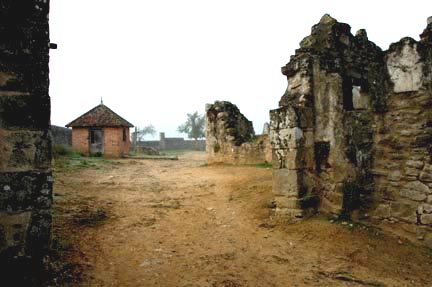The Tragic Well of Oradour-sur-Glane

One of the first sights on the entrance
road is the "Tragic Well," where dead bodies that had
been thrown into the well were found. The photo above shows the
entrance to the ruins of the farm where the well is located.
The photo below was taken from inside the enclosure of the old
farmstead; it shows the old well with a wooden cross placed beside
it.

According to Philip Beck, who wrote a
book about Oradour-sur-Glane, entitled "Oradour, Village
of the Dead," the names of the victims whose bodies were
found in the well are unknown. Out of the 642 people murdered
in the village by the SS soldiers, the bodies of only 52 were
ever identified. According to defense testimony at the Nuremberg
IMT, the SS claimed to have found a number of bodies of German
soldiers who had been executed in Oradour-sur-Glane.
The entrance street into the ruined village
is the former road to St. Junien, a town that is 13 kilometers
southwest of Oradour-sur-Glane. The Waffen-SS soldiers who destroyed
this peaceful village on 10 June 1944 were coming from St. Junien,
but they didn't use the present entrance road to enter the village.
Instead, they traveled south and entered the village at the southern
end, which is now closed off. Originally tourists were allowed
to enter the ruined village from three gated entrances, including
the present entrance.
The photo below shows the entrance road,
early on a foggy morning, before the arrival of the many tour
groups which stop here. Most of the visitors are older French
citizens. The entrance road comes to a dead end where it intersects
with the main street, called Rue de Emile Desourteaux. The building
on the left side of the photo is the same building that is shown
in the second photo below.


The last entry to the ruins was at 5
p.m. and the gate to the village was closed at 6 pm. (The village
stays open longer during the summer months.) The photo above,
taken on the entrance street on the way back, at the end of a
long day, shows the shell of a building that is near the intersection.
The same building is shown on the left in the photo right above
this one.
There are 254 ruined buildings that make
up the old village. Even before World War II ended, in a meeting
on 28 November 1944, the provisional French government, under
the leadership of President Charles de Gaulle, adopted a proposal
to make the ruins a historical site. Oradour-sur-Glane is called
a "martyred village," which establishes the theme that
the innocent French were victims of the barbaric Germans and
that the ruins have a religious significance as a pilgrimage
site to honor the martyrs for France who died here.
|